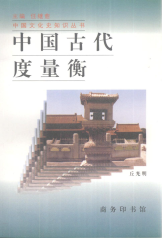
主要责任者: 丘光明
责任方式: 著
出版者: 商务印书馆
出版地: 北京
字数: 92 千字
页码: 1-203
开本: 32
中图分类号: TB9-092.2
装帧: 简
语种:中
定价:11.80
出版时间:1996-12
丛书多卷书否:是
丛书名:中国文化史知识丛书
丛书责任者:任继俞;汤一介,焦树安,张明华
丛书责任方式:主编;副主编
书目简介:本册工具书是中国文化史知识丛书之一,共收录33条词条。
被引频次:87
| 词条 | 中国古代度量衡 |
| 类别 | 中文百科知识 |
| 释义 |  主要责任者: 丘光明 责任方式: 著 出版者: 商务印书馆 出版地: 北京 字数: 92 千字 页码: 1-203 开本: 32 中图分类号: TB9-092.2 装帧: 简 语种:中 定价:11.80 出版时间:1996-12 丛书多卷书否:是 丛书名:中国文化史知识丛书 丛书责任者:任继俞;汤一介,焦树安,张明华 丛书责任方式:主编;副主编 书目简介:本册工具书是中国文化史知识丛书之一,共收录33条词条。 被引频次:87 |
| 随便看 |
开放百科全书收录579518条英语、德语、日语等多语种百科知识,基本涵盖了大多数领域的百科知识,是一部内容自由、开放的电子版国际百科全书。